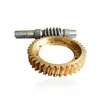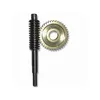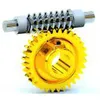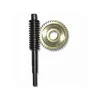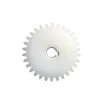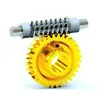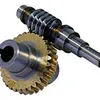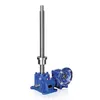A worm gear is a type of gear system that consists of a worm (which resembles a screw) and a worm wheel (which resembles a typical gear). This setup allows for high reduction ratios and smooth, quiet operation, making it ideal for applications requiring precise motion control and high torque. Worm gears are widely used in industries such as automotive, manufacturing, and robotics due to their durability and efficiency in transmitting power at right angles.
Our worm gears are engineered with precision to meet rigorous industrial standards. Below are the detailed specifications:
| Parameter | Range | Unit |
|---|---|---|
| Gear Ratio | 5:1 to 100:1 | Ratio |
| Module Size | 1 to 10 | mm |
| Efficiency | 50% to 95% | Percentage |
| Operating Temperature | -20°C to 150°C | Degrees Celsius |
| Load Capacity | Up to 5000 Nm | Newton-meter |
| Backlash | Adjustable from 0.05 to 0.2 mm | Millimeter |
Worm gears are versatile and can be found in various machinery and systems. Common applications include conveyor systems, elevators, packaging equipment, and automotive steering mechanisms. Their ability to provide high torque in a compact design makes them suitable for space-constrained environments.
What is a worm gear used for?
A worm gear is primarily used for power transmission between non-intersecting shafts at right angles, offering high reduction ratios and self-locking capabilities in many cases.
How does a worm gear work?
The worm (screw) meshes with the worm wheel (gear), and as the worm rotates, it drives the wheel. This mechanism allows for smooth motion and high torque output with minimal backlash.
What are the advantages of using a worm gear?
Advantages include compact size, high reduction ratios, quiet operation, and the ability to handle shock loads effectively. They are also self-locking in certain configurations, preventing reverse motion.
How do I maintain a worm gear system?
Regular lubrication is crucial to reduce wear and extend lifespan. Use recommended lubricants and check for signs of wear or misalignment periodically. Clean the system to prevent contamination.
Can worm gears be customized?
Yes, we offer customization options for materials, sizes, ratios, and coatings to meet specific application requirements. Contact our team for tailored solutions.
What is the typical efficiency of a worm gear?
Efficiency ranges from 50% to 95%, depending on the gear ratio, materials, and lubrication. Higher ratios generally have lower efficiency due to increased friction.
Are worm gears reversible?
In most cases, worm gears are not reversible due to the self-locking feature, which prevents the worm wheel from driving the worm. However, some designs allow reversibility with specific parameters.
What materials are best for worm gears?
Hardened steel for the worm and bronze for the worm wheel are common due to their durability and friction-reducing properties. Material choice depends on the application environment and load requirements.
